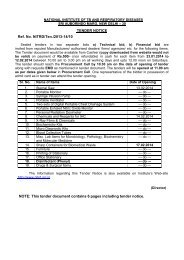The Indian Journal of Tuberculosis - LRS Institute of Tuberculosis ...
The Indian Journal of Tuberculosis - LRS Institute of Tuberculosis ...
The Indian Journal of Tuberculosis - LRS Institute of Tuberculosis ...
You also want an ePaper? Increase the reach of your titles
YUMPU automatically turns print PDFs into web optimized ePapers that Google loves.
4 V. SIVARAMAN ETAL<br />
(c) India<br />
<strong>The</strong> <strong>Indian</strong> Council <strong>of</strong> Medical Research<br />
(ICMR) in collaboration with the Directorate<br />
General <strong>of</strong> Health Services has built up a network<br />
<strong>of</strong> 43 surveillance and 5 reference centres to carry<br />
out a serosurveillance <strong>of</strong> HIV infection in the<br />
country. Of the 580,824 high-risk group persons<br />
screened during October 1985 to October 1990,<br />
4,082 (7.0 per 1000) were found to be HIV<br />
positive, including 57 AIDS patients 11 - Extensive<br />
disseminated tuberculosis was seen only in 2<br />
patients 113<br />
Our group in Pondicherry screened 225<br />
tuberculosis patients admitted in TB Sanatorium,<br />
and the method outlined by Murray 13 , a<br />
computerised mathematical model has been<br />
developed to estimate the impact <strong>of</strong> HIV<br />
infection on tuberculosis epidemiology within a<br />
wide range <strong>of</strong> assumptions :<br />
(1) Seroprevalance <strong>of</strong> HIV in general<br />
population varies from 0.07 to 1.75 per 1000 (i.e.<br />
1 to 25% <strong>of</strong> the general population is at risk and 7<br />
per 1000 among them develop HIV infection).<br />
(2) Seroprevalence <strong>of</strong> HIV among TB<br />
patients varies from 1% to 6% (corresponding to<br />
95% confidence limits <strong>of</strong> our Pondicherry<br />
patients).<br />
Figure 2 shows the estimated impact <strong>of</strong> coinfection<br />
with HIV on the incidence <strong>of</strong> TB<br />
Fig. 1. Conceptual mode] <strong>of</strong> inter relationship <strong>of</strong> HIV infection and tuberculosis<br />
Pondicherry and suspected to be harbouring HIV<br />
infection and found 6 to be seropositives 12 .<br />
Applying the 95% confidence limits to this selective<br />
study, we can assume that roughly between<br />
1% to 6% <strong>of</strong> the tuberculous patients might be<br />
HIV seropositive in this area. <strong>The</strong> assumption,<br />
based on so limited and selective data has been<br />
made in order to understand the relationship<br />
between HIV infection and tuberculosis,<br />
A conceptual model <strong>of</strong> the inter relationship<br />
between HIV and tuberculosis is shown in figure<br />
1, along with the flow rates applicable to the<br />
<strong>Indian</strong> epidemiological conditions. Based on this<br />
disease. For a given Seroprevalance, the incidence<br />
among TB population shows very little variation<br />
when the seroprevalence in the community varies.<br />
Figure 3 shows time trend <strong>of</strong> the prevalence <strong>of</strong><br />
TB under <strong>Indian</strong> conditions, with 3 different<br />
seroprevalence <strong>of</strong> HIV infection. <strong>The</strong> HIV<br />
related increase in the prevalence <strong>of</strong> tuberculosis<br />
may be considerable (<strong>The</strong> graph is computer<br />
generated from the model described by<br />
Sivaraman et al 14 <strong>The</strong> input parameters are the<br />
same as the program A but the incidence rate is<br />
higher and is derived by the method described by<br />
Murray 13 ).

















